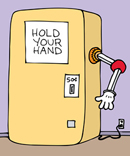 |
Bryan Urbick
Bryan is co-founder, CEO and Chairman of the Consumer Knowledge Centre. He worked previously in marketing and product development in the food industry and the banking/financial services industry.
Read the full biography here. |
Hyper-personalization
a gift for researchers? (even if Greeks can't bear it)
By Bryan Urbick - 18th February, 2011
It is an interesting fact how every advance in technology, through the ages, has had its intense criticism. It appears, too, that the same arguments revive across the centuries, albeit against new things. Socrates, in his work, ‘Phaedrus’, lamented the invention of the book, which he felt “creates forgetfulness in the soul” - so what would he have said about the Internet? Sure enough, the ‘Net finds itself under similar scrutiny and blamed for everything from lack of focus to violence.

Some years ago the great new advance we were promised was customization, no more ‘one size fits all’. On the surface it may seem like all our Christmases coming at once for a company that spends a lot of its time conducting segmentation exercises: in essence, respondents segmenting themselves. In fact, customization is here and it is today’s young people that are very much at the forefront of the current evolution, which can best be described as ‘hyper-personalization’.
One of the drivers of customization is the availability of different versions of a brand (for example all the different formats in which one can now buy a coke) but another, especially in the youth market which we specialize in, is neophobia. This is something which brand managers and marketers need to strongly consider as they develop products for and grow brands with the youth market in mind. Neophobia is the fear of new things and it is something which we have researched in great depth. We regularly uncover how kids will claim they want new games, new foods, and new experiences - yet in fact their behaviour indicates that they really desire more an extension of that with which they are already familiar. Hyper-personalization therefore is an ideal way for brands to introduce new concepts via a ‘familiar’ delivery. In this case the familiarity is based on personal expression of one’s self.
Where do we look for examples of this hyper-personalization? FaceBook and MySpace are just a couple of examples where kids have created their own distinguishing identities. They have taken to creating their personal avatars and developed virtual personas. Even the very young know all about Club Penguin, and those younger still are able to demonstrate ‘creating their person’ (a Mii) for various Wii games.
Over a typical year we will work qualitatively with some 4,000 kids across the globe. No matter their language, their culture or their demographic background they generally expect to be able to ‘create’ their own worlds. This, therefore, is a wonderful opportunity for brands to keep in step with their customers, allowing them to demonstrate what they want, allowing them to feel like they are taking over the reins, to re-model a brand in their own image or even to allow it to help them decide who they are.

It may sound like something out of a science fiction movie yet Japan has already developed drink dispensers with 47-inch OLED touch-screens, sensors and internal cameras. When someone comes close, the internal cameras are activated and connect via WiMax to face and body recognition software that uses statistical data to guess the age and sex of the consumer. The maker claims that the "recognition" is about 75 percent accurate. The display then creates a custom screen for this demographic and presents beverage options that match their profile. This intelligent menu certainly gives extra spin to the concept of target marketing and personalization, although it could be argued that it leaves itself open to potential charges of discrimination and breach of privacy. As this technology advances, it is not too unbelievable to accept that the recognition will be able to predict what the consumer wants, ready to offer it – customized service, from a vending machine.
A less hi-tech approach, yet no less effective, is drinks company, Jones Soda, which encourages customers to send in their photos which later appear on the drinks’ labels. M&Ms allowing personal messages to be printed on the confectionery pieces is another example. Sharpie pens with personalized messages is yet another.
The challenge for us as researchers is to understand and quantify these customizations - the boxes into which our client’s consumers put themselves - so that we can extrapolate from their current preferences to their future buying behaviour.
Hyper personalization goes right across all sectors from the media to search engines - there is little doubt that this is where every corporation and brand wants to be or at least wants to be seen as being. Certainly as our kids create and re-create their virtual identities and we stream our own individual interests there are almost as many opportunities for brands as there are pitfalls. Key really is for brands to acknowledge that they need to keep predicting what the consumer wants even before the consumer realizes that they want it - then they just need to help us understand that it was our decision in the first place!

Bryan Urbick
Comments on this article

Want to share your thoughts...?
NOTE: Please note that this board is moderated, and comments are published at the discretion of the site owner.
|